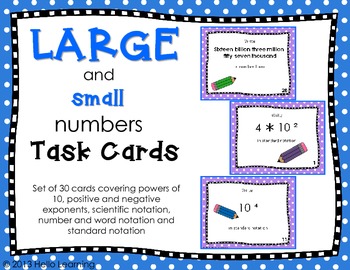Large & Small Number Task Cards- powers of 10, exponents and scientific notation
Hello Learning
3.4k Followers
Grade Levels
5th - 8th, Homeschool
Subjects
Resource Type
Standards
CCSS5.NBT.A.2
CCSS6.EE.A.1
CCSS8.EE.A.1
CCSS8.EE.A.3
CCSS8.EE.A.4
Formats Included
- PDF
Pages
14 pages
Hello Learning
3.4k Followers
What educators are saying
I used this as a review of converting from Standard to Scientific Notation and vice versa. More engaging than a worksheet.
Description
Students will practice exponents, scientific notation and more while working with large and small numbers in this set of 30 task cards.
This set of 30 task cards covers the concepts of:
exponents (positive and negative exponents)
scientific notation
number and word notation
standard notation
exponential notation
number and word notation
Task cards can be used as a whole class activity, and part of a guided math rotation, as a math center, as math homework, with a parent volunteer, and more!
This set of 30 cards includes an answer key, student answer sheet and suggestions for different ways to use task cards.
For more practice with powers of 10, check out:
Powers of Ten Task Cards
This set of 30 task cards covers the concepts of:
exponents (positive and negative exponents)
scientific notation
number and word notation
standard notation
exponential notation
number and word notation
Task cards can be used as a whole class activity, and part of a guided math rotation, as a math center, as math homework, with a parent volunteer, and more!
This set of 30 cards includes an answer key, student answer sheet and suggestions for different ways to use task cards.
For more practice with powers of 10, check out:
Powers of Ten Task Cards
Total Pages
14 pages
Answer Key
Included
Teaching Duration
Lifelong tool
Last updated Oct 13th, 2013
Report this resource to TPT
Reported resources will be reviewed by our team. Report this resource to let us know if this resource violates TPT’s content guidelines.
Standards
to see state-specific standards (only available in the US).
CCSS5.NBT.A.2
Explain patterns in the number of zeros of the product when multiplying a number by powers of 10, and explain patterns in the placement of the decimal point when a decimal is multiplied or divided by a power of 10. Use whole-number exponents to denote powers of 10.
CCSS6.EE.A.1
Write and evaluate numerical expressions involving whole-number exponents.
CCSS8.EE.A.1
Know and apply the properties of integer exponents to generate equivalent numerical expressions. For example, 3² × (3⁻⁵) = (3⁻³) = 1/3³ = 1/27.
CCSS8.EE.A.3
Use numbers expressed in the form of a single digit times an integer power of 10 to estimate very large or very small quantities, and to express how many times as much one is than the other. For example, estimate the population of the United States as 3 × 10⁸ and the population of the world as 7 × 10⁹, and determine that the world population is more than 20 times larger.
CCSS8.EE.A.4
Perform operations with numbers expressed in scientific notation, including problems where both decimal and scientific notation are used. Use scientific notation and choose units of appropriate size for measurements of very large or very small quantities (e.g., use millimeters per year for seafloor spreading). Interpret scientific notation that has been generated by technology.





